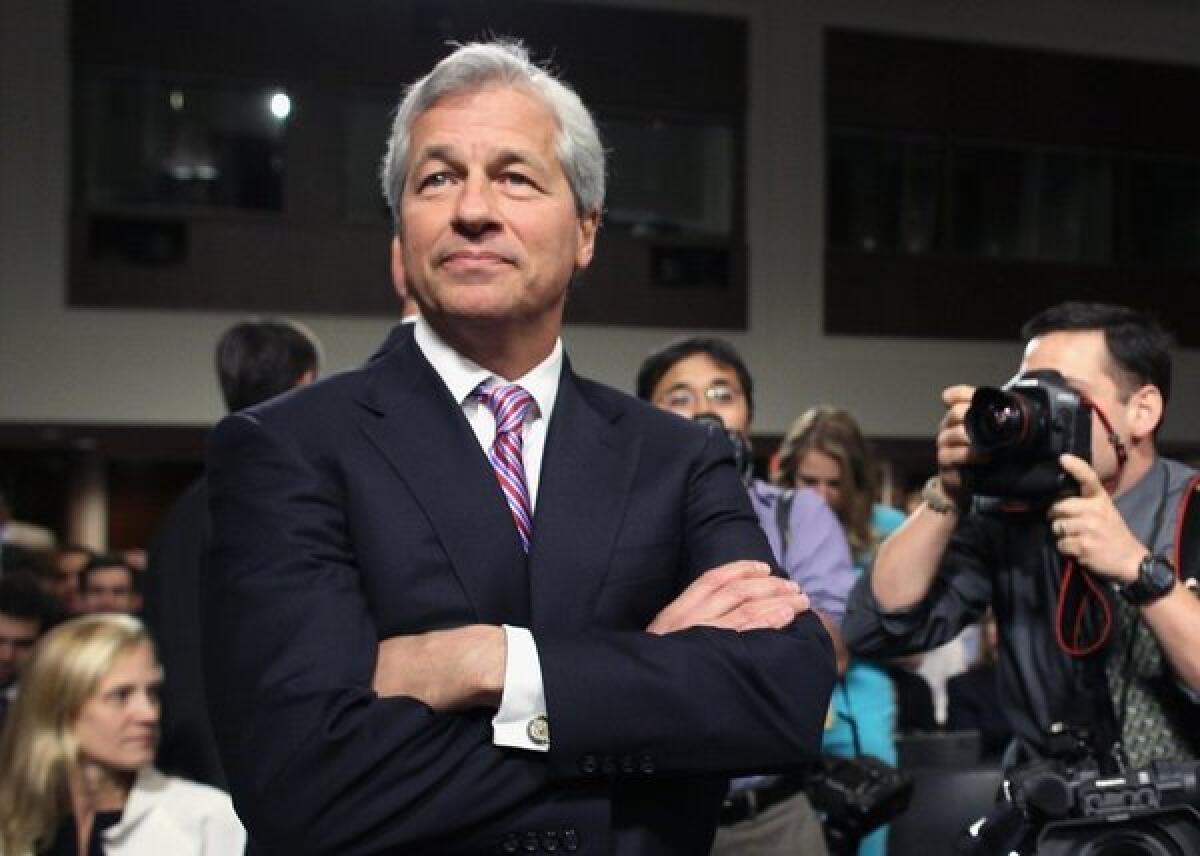Bottom line on JPMorgan’s $13-billion settlement: not nearly enough

Still riding high: JPMorgan Chairman and CEO Jamie Dimon, unfazed by a $13-billion hit.
- Share via
The headline number on the big JPMorgan Chase legal settlement with state and federal regulators hasn’t changed in the weeks since the negotiations over the deal first broke into the open: $13 billion. The deal’s sponsors are falling all over themselves to point out that it’s the “the largest settlement with a single entity in American history,” to quote the Department of Justice.
Here’s what else hasn’t changed: It’s not enough. The money isn’t sufficient to compensate the public for the damage done to the economy by JPMorgan Chase and Bear Stearns & Co. and Washington Mutual, the two banks that it acquired in 2008 and were involved in the same chicanery in the mortgage-backed security market that is the subject of the settlement.
Moreover, it’s only money. JPMorgan says it’s already reserved against the settlement, meaning there will be no additional hits to its financial results as a result of the deal. The bank isn’t admitting wrongdoing in conjunction with the settlement.
“We did not admit to a violation of the law,” Chairman and Chief Executive Jamie Dimon said Tuesday, referring to an 11-page statement of facts to which the bank acceded as part of the deal. No one is known to have lost his or her job as a result of these activities; Dimon, who presided over the firm during all the activities concerned, remains chairman, chief executive and the apple of the investment community’s eye.
On the brighter side, JPMorgan is still the target of a criminal investigation by federal prosecutors in Sacramento. Someone who walks and talks like a human being, rather than the abstract concept known as a “corporation,” may yet be brought to book for crashing to the mortgage economy.
A few further points about this supposedly groundbreaking agreement are worth noting.
First, of the $13-billion total, $7 billion is tax deductible by JPMorgan. That could save the company nearly $2.5 billion, based on the top U.S. corporate tax rate of 35%.
Another $4 billion represents a settlement the bank reached earlier with the Federal Housing Finance Agency, the regulator overseeing Fannie Mae and Freddie Mac. That deal was folded into this one. So if you’re treating them as distinct deals, you’re double-counting.
Another $4 billion is not a cash outlay, but mortgage relief. That includes $2 billion in forgiveness of principle for homeowners with underwater mortgages -- relief “targeted to keep people in their homes,” as Morgan Chief Financial Officer Marianne Lake described it during a conference call Tuesday.
That’s not a fine or a penalty. It’s relief that is sure to save Morgan money in the long run, for there’s nothing more costly for a mortgage lender than having borrowers go into foreclosure. There’s not even any guarantee that those loan modifications will be separate from or additional to arrangements the bank already has agreed to pursue as a result of previous mortgage settlement or in its own self-interest.
The second $2-billion in the mortgage component involves “credits” the bank will receive to bump up lending in low-income communities and deliver other relief. There, too, we can assume that those steps will end up profiting the bank, one way or another.
Much as been said by JPMorgan’s friends in the investment community and the financial press about how the poor, beleaguered bank is being squeezed to pay for the misdeeds of Bear Stearns and WaMu. Supposedly the federal government pressured Morgan into taking over those crippled institutions during the dark days of the financial crisis; what ingratitude that the feds then turn around and sock Morgan for those banks’ misdeeds.
Several misconceptions are packed into this line of chatter. To begin with, JPMorgan had been sniffing around both quarries in the months before the financial crisis struck. Dimon was prepared to pay premium prices for both. Bear Stearns had a book value of about $12 billion shortly before Morgan took it over for $1.5 billion. It’s fair to say that Bear lost some value during the crisis, but not that much
As for WaMu, Morgan had offered to buy the bank for $9 billion in April 2008, just before the crisis bit, the Wall Street Journal reported. Its ultimate price: $1.9 billion.
At the time of those acquisitions they were both treated as a steal, and Dimon as the canniest operator on the street, someone who had taken the big bad federal government to the cleaners. That judgment is still correct. The deals -- WaMu especially -- helped propel Morgan to the very pinnacle of the financial services industry, where it still reigns. As the financial analyst Yves Smith said recently, Dimon “has made out wonderfully on Washington Mutual. Crying that this was a bad deal is ludicrous.”
Morgan knew from the start that it was acquiring the firms’ liabilities along with their assets. The two banks account for about $6.5 billion of the settlement, almost all of it tax deductible. If you think JPMorgan somehow got cheated in this deal, let’s hear you explain why.
More to Read
Inside the business of entertainment
The Wide Shot brings you news, analysis and insights on everything from streaming wars to production — and what it all means for the future.
You may occasionally receive promotional content from the Los Angeles Times.











